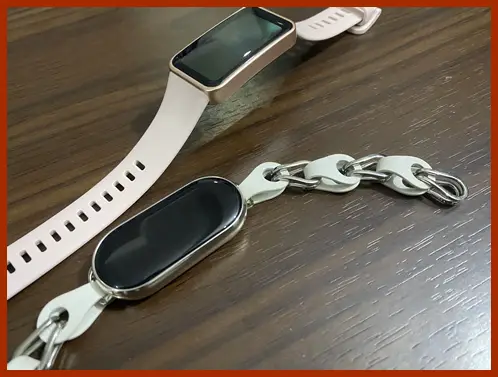The race to dominate the wearable market is on and even more intense. Just a day after Huawei released the Huawei Band 8, Xiaomi followed up with the release of the Mi Band 8. These two smartbands come in awesomely comfortable designs and are very fitness-focused. The Huawei Band and Mi Band series are some of the most popular fitness trackers and over the years we have witnessed upgrades from previous generations. This year, these two also welcome slight upgrades from their respective predecessors. And considering their relatively similar prices, it’s a dicey call between the Huawei Band 8 and Mi Band 8. However, don’t worry, this post takes a look at what each of these has to offer, and hopefully, I can help you decide.
Huawei Band 8 vs Mi Band 8 Full Specifications
[yith_woocompare_table products=”9187,9202″]
Difference Between Huawei Band 8 vs Mi Band 8
- Design
- Display – Mi Band 8 has a better display
- Activity Tracking – Too close to call
- Battery Life – Mi Band 8 lasts longer
- Notifications – Too close to call

The Huawei Band 8 and Mi Band 8 can perform very similar functions and the battery life is almost the same. Where the main difference lies between these two is in the shape and design, and without mincing words, I think the Mi Band 8 has a more stylish design.
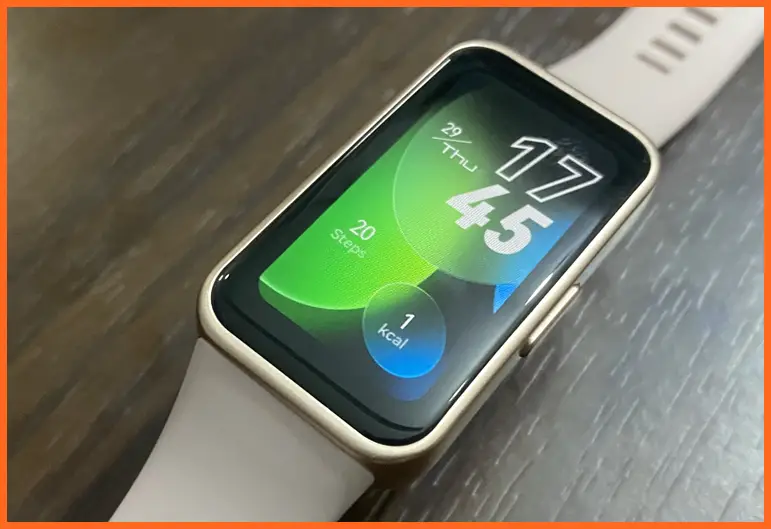
Although the Huawei Band 8 is also very stylish. Unlike its predecessor with curved edges, it has flattened edges which no doubt makes it very attractive.
Both devices are durably built, and the Mi Band 8 spots an NCVM-coated frame that results in a metal texture appearance. In contrast, the Huawei Band 8 has a frame made of polymer which is also very durable.
Furthermore, the Huawei Band 8 comes in the regular rectangular shape while Mi Band 8 retains its pill shape.
The Huawei Band 8 comes in at 8.99 mm thick which makes it one of the slimmest wearable. In contrast, the Mi Band 8 is 10.99mm, yet still very slim. Moreover, while both Bands are very lightweight, Huawei Band 8 weighs a little less.
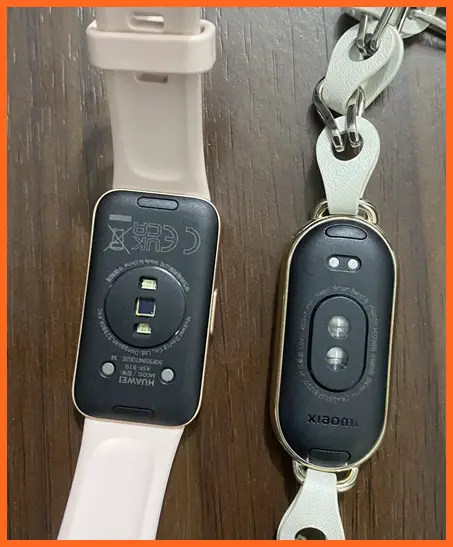
Coming from their respective predecessors, both smartbands also welcome redesigned strap hooks. Unlike the Mi Band 7 and older Mi Band models where you have the straps encircling the Band, the Mi Band 8 has a quick-release strap that makes it easy to swap the straps. Similarly, unlike Huawei Band 7 where you have to push down a pin, the Huawei Band 8 has a quick-release design that makes swapping the straps very easy.
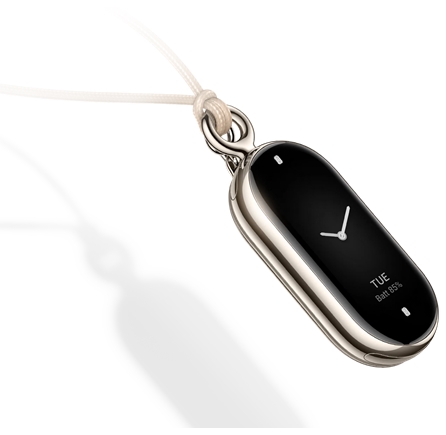
Furthermore, while the Huawei Band 8 can only be worn on the wrist, Xiaomi for the first time has designed the Mi Band 8 to be worn in different ways. There’s a pendant form that can be worn as a necklace. For avid runners, the Mi Band 8 can also be attached to your shoes.
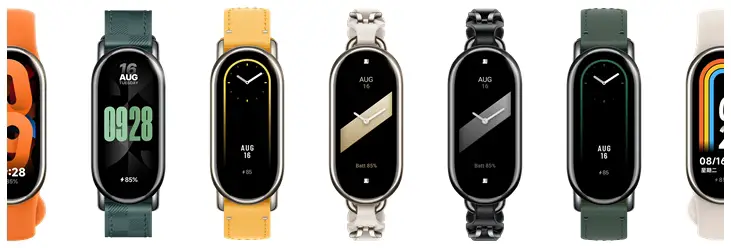
Moreover, the straps come in leather, silicone, nylon, and the metal/leather bracelet combo. The unit that comes with silicone straps is the basic model, and it’s the cheapest. I ordered the stainless steel bracelet straps and I find it very attractive.
In addition, both wearables are rated 5ATM which translates to being water resistant up to 50 meters. It’s safe to wear any of these to the shower or even to the swimming pool.
Overall, in terms of design, Xiaomi actually got innovative with the Mi Band 8. This has resulted in a finer and more classy Band that’s already trending. Nonetheless, I think it’s a tie. Both smartband look very attractive.
Like their respective predecessors, AMOLED powers the display of both bands. The display of these two is very bright and can easily be read in any light condition. Though, Xiaomi has added an ambient light sensor to the Mi Band 8 which Huawei Band 8 lacks. This sensor means that the brightness of the Mi Band 8 will automatically adjust depending on the prevailing light in the environment. This also means you don’t have to manually adjust the display brightness every now and then.
Moreover, Mi Band 8 at 600nits has a brighter display than Huawei Band 8’s 450nits. Mi Band 8 also has a more colorful display.
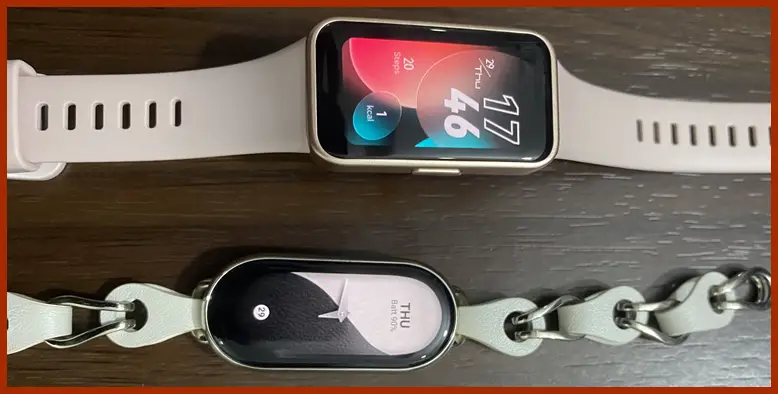
The display size is also different. While Huawei Band 8 has a 1.47 inches display Mi Band 8 has a 1.62 inches display. However, in reality, the rectangular shape of the Huawei Band 8 leaves it with a bigger aspect ratio that will allow you to see more at a glance.
Both watches have a touch-sensitive screen, though the Huawei Band 8 also has a physical button by the side. Nonetheless, the Mi Band 8 is still easy to interact with.
The watch face of both smartbands can be changed, and you get loads of watch faces in the respective companion apps. It’s the Mi Fitness app for Mi Band 8 and the Huawei Health app for the Huawei Band 8. Both devices will allow you to store a couple of watch faces onboard the device.
To change the watch face on both Bands is easy, simply press and hold on to the homescreen to highlight the current watch face, then swipe through to select another watch face.
In terms of the display, Mi Band 8 has a better display. It’s brighter, more colorful and there’s an ambient light sensor.
As per activity tracking, these two share a lot of similarities. Each of these is equipped with a heart rate sensor, accelerometer and gyroscope. These sensors enable the Bands to track your steps, calories, sleep, heart rate, blood oxygen and stress. These two also feature menstrual cycle logging for women.
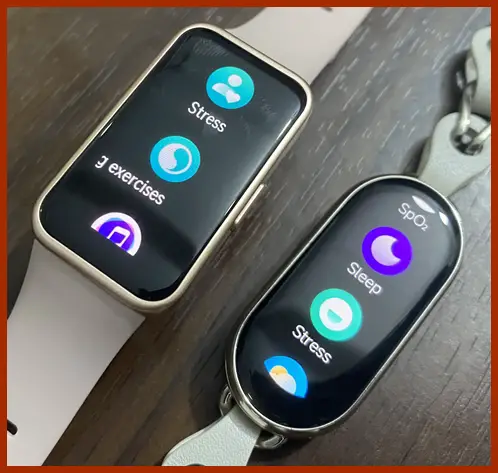
The Huawei Band 8 and Mi Band 8 will continuously track your heart rate, blood oxygen and stress. You need to enable automatic tracking to continuously monitor these vitals. Both Bands have a breathing exercise app that can help you reduce stress by guiding you through a breathing session. I compared the heart rate tracking accuracy of both Bands against Galaxy Watch 5 Pro and Omron heart rate monitor, the results showed the Huawei Band 8 and Mi Band 8 to be consistent heart rate trackers.
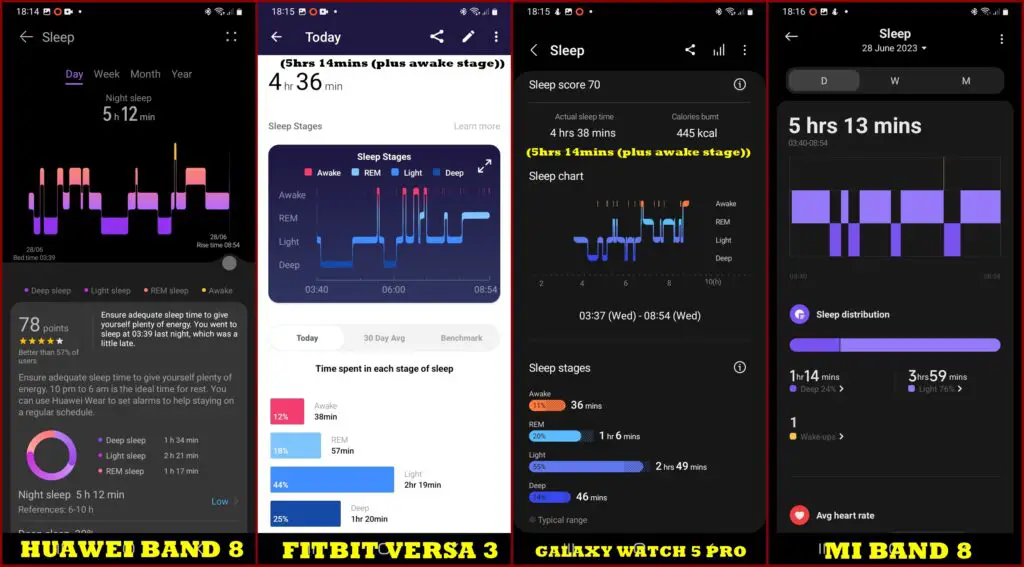
Each of these two will track your sleep in all 4 stages of sleep. When you wake up in the morning, you will be able to view your sleep details directly on the Band. I compared the sleep tracking accuracy of both smartbands against Versa 3 and Galaxy Watch 5 Pro. From my tests, the Huawei Band 8 and Mi Band 8 did a pretty decent job tracking my sleep.
Like their respective predecessors, the Huawei Band 8 and Mi Band 8 also lack inbuilt GPS. However, these two can still map your routes as long as you carry your phone along.
From my experience, the Mi Band 8 has a better-connected GPS function. You simply need to start an outdoor workout on the device and it will automatically connect to your phone’s GPS. With Huawei Band 8, you must start the outdoor workout on your phone otherwise it won’t map your routes nor will it track your pace and other metrics accurately. I encountered a similar problem with Huawei Band 7, I’d hoped it would be fixed but unfortunately, it’s still the same issue on its successor. In essence, to accurately track your routes and pace during an outdoor activity with the Huawei Band 8 you must start the workout from the Huawei Health app.
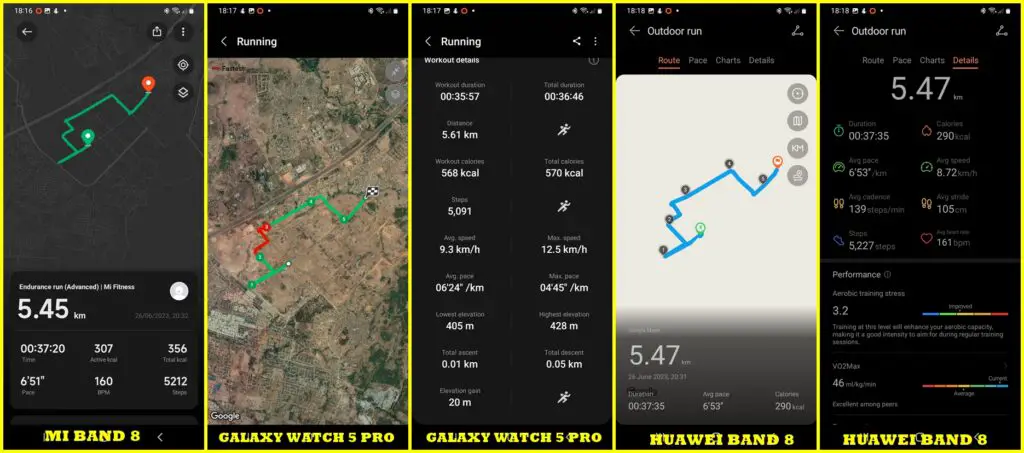
I compared the route mapping accuracy of the Mi Band 8 and Huawei Band 8 against the Galaxy Watch 5 Pro. The results were pretty consistent as you can see from the result above.
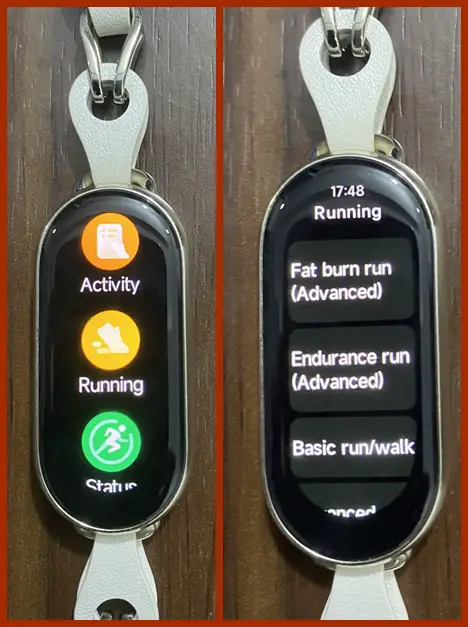
Interestingly, the Mi Band 8 has a running coach app that features a couple of running modes that can help you train more efficiently.
In terms of sports modes, each of these two comes with loads of preloaded sports modes. Though the Mi Band 8 features over 150 sports modes while Huawei Band 8 features 100 sports modes.
Overall, in terms of activity tracking, the Mi Band 8 can track the same activities as Huawei Band 8, though it has more sports modes and the connected GPS function works better.
Considering their smaller displays, smartbands normally have long battery life, and the Huawei Band 8 and Mi Band 8 are no exception. These two have battery life spanning up to 2 weeks from a single charge.
Xiaomi claims that in typical usage you can get up to 16 days battery life with Mi Band 8. This is slightly longer than the Huawei Band 8 which offers up to 14 days of battery life.
Although with always-on enabled, brightness set to the midpoint, and continuous monitoring for heart rate, stress and blood oxygen all enabled. Worn to sleep daily and notifications enabled for 10 apps, I got 9 days with Huawei Band 8 and about 10 days with Mi Band 8.
Both watches support fast charging just like their respective models. It took me about 45 minutes to fully charge the Huawei Band 8 and about 55 minutes to fully charge Mi Band 8.
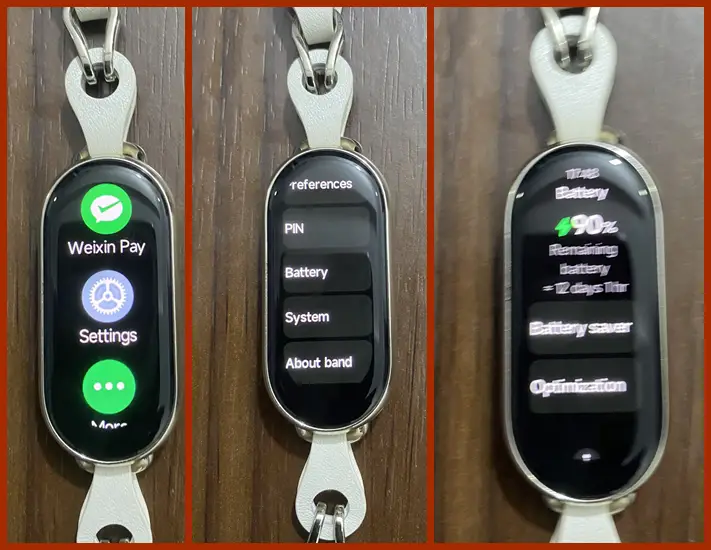
Despite having a slightly longer battery life, the Mi 8 has a battery saver mode which Huawei Band 8 lacks. Activating the battery-saver mode will allow you to get an even longer battery life.
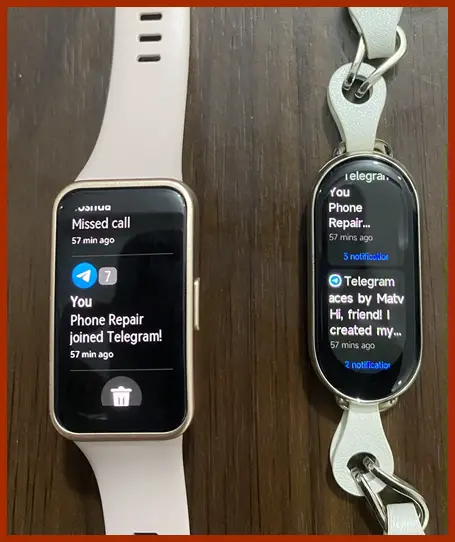
Smartwatches and smartbands are designed to work with your phone and will inform you when you receive a notification. While Huawei Band 8 can be paired with the Huawei Health app, Mi Band 8 can be paired with the Mi Fitness app. Once paired to their respective companion apps and notifications is enabled for your preferred apps, you should get notifications every time a message arrives on your phone. And you have the option to reply to messages with quick replies. Note that the quick reply function of Mi Band 8 is only available when you pair the Band with the Zepp Life app.
When there is an incoming call, you will have the option to either reject the call outrightly or reject the call with quick replies.

Both Bands feature Utility apps such as timer, stopwatch, weather, alarm and torchlight apps. These two also feature a remote music control and find my phone apps.
Huawei Band 8 vs Mi Band 8 – My Verdict
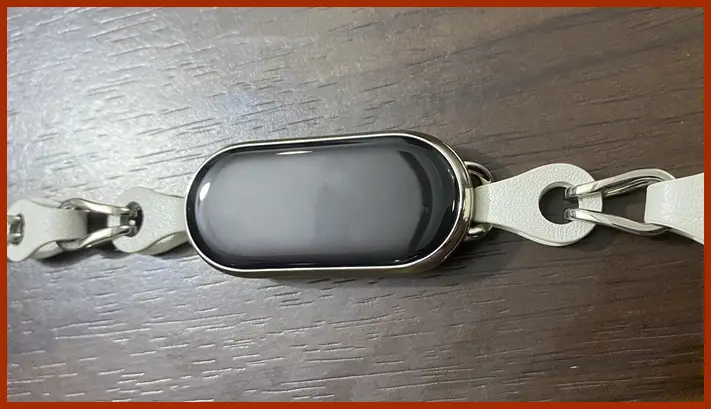
While both smartbands are outstanding, I will go with the Mi Band 8. It has a better display, more sports modes and a slightly longer battery life. The connected GPS function works perfectly fine and it’s also very stylish.
On the hand, the Huawei Band 8 is still an adorable piece. Its rectangular shape leaves with a smartwatch appearance. Moreover, It’s a comprehensive activity tracker with a slightly bigger display and a long battery life that lets you go long from a single charge.

